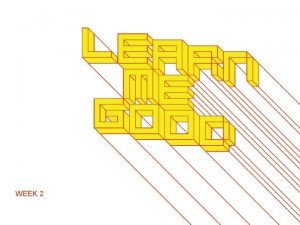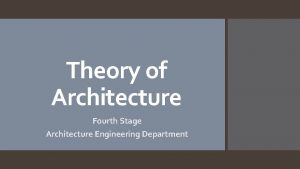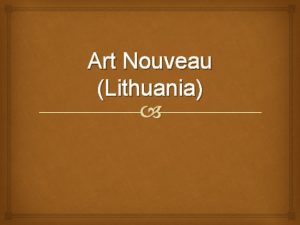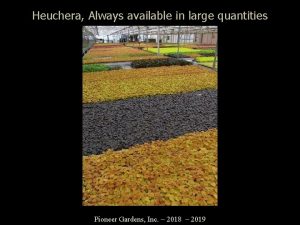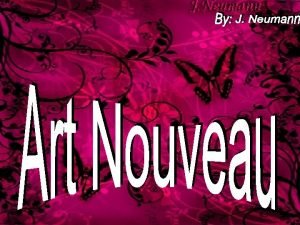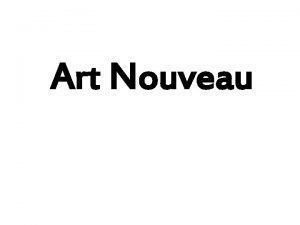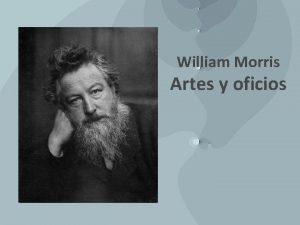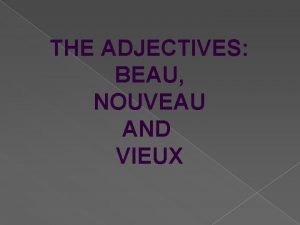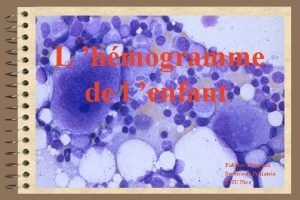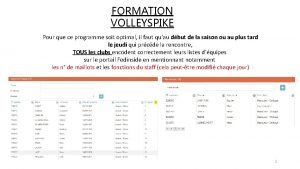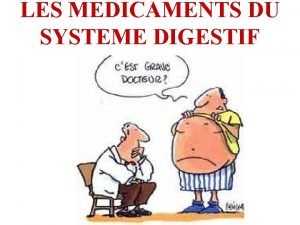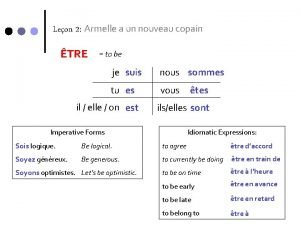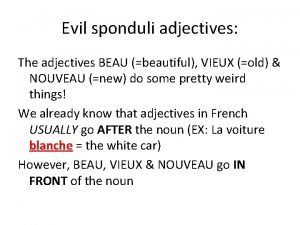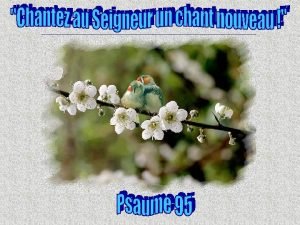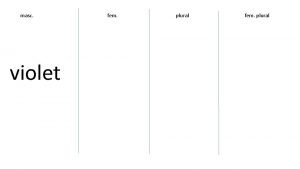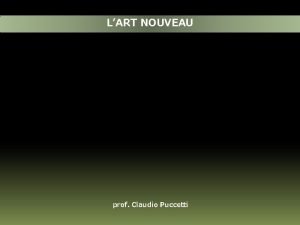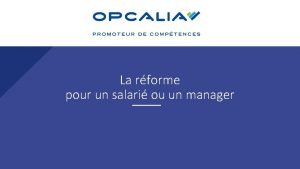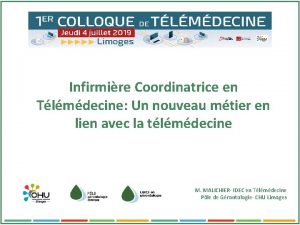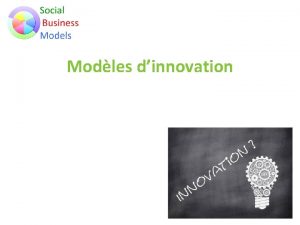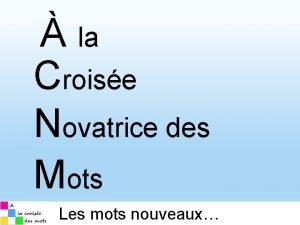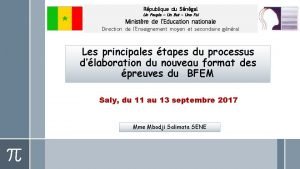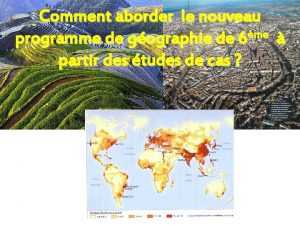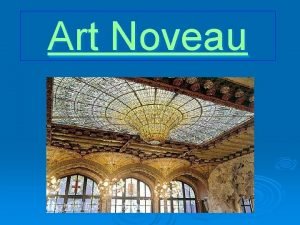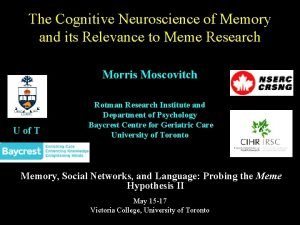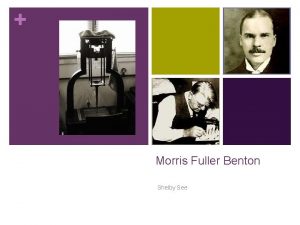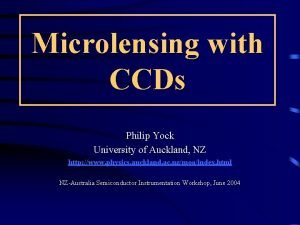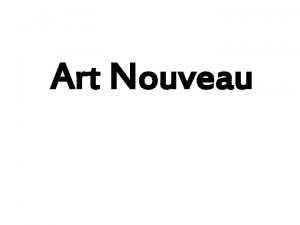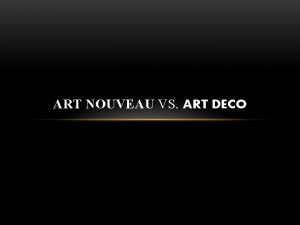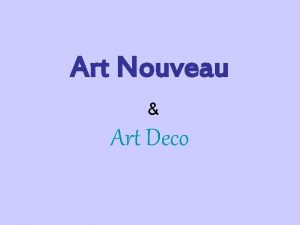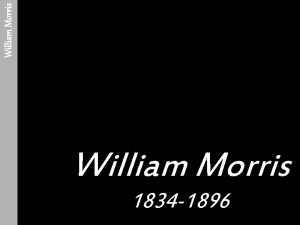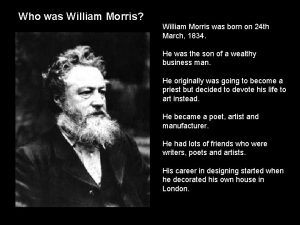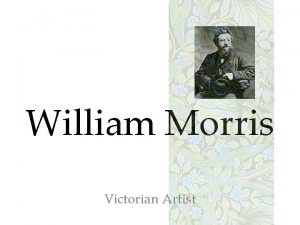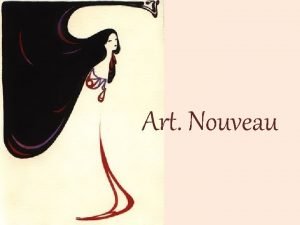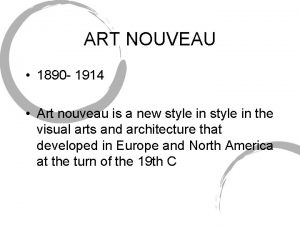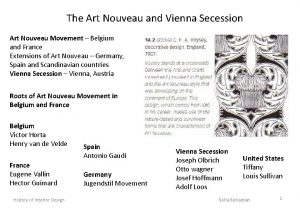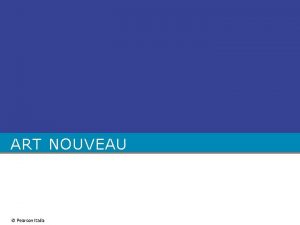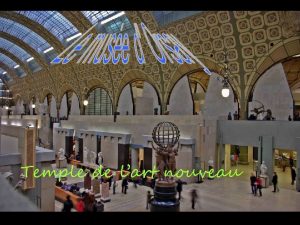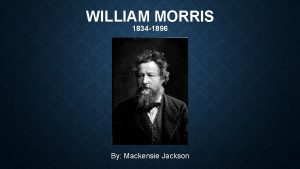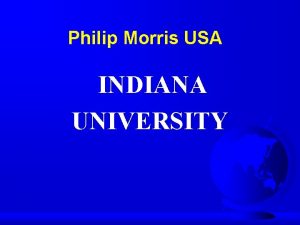WEEK 2 week 2 william morris art nouveau

































- Slides: 33

WEEK 2

week 2: william morris, art nouveau + industrialization + Overview + Heads-Up: +Lecture + William Morris and the Arts and Crafts Movement + Evolution of Art Nouveau + Break + Program Information + Information on Program Guides + Tutorial Activity and Video Screening + Arts and Crafts discussion + Video screening: Thank You for the Music, Dir. Mika Taanila (20: 00) + Agendas + Note key dates and deliverables 2

week 2: william morris, art nouveau + industrialization + Migration to Cities and the Aesthetic Impacts of Mass Production + Early Industrial Revolution: + Late 18 th - early 19 th century + Major shifts in agriculture, manufacturing, mining, and transport + Manual labour and animal-based farming shifted to factory and machine production + Result of major developments in science: the dominating cultural influence of the late 17 th - early 18 th centuries + Change in socio-economic and cultural conditions + Almost every aspect of modern life influenced + Mass migration to city centres to seek steady employment + Secondary businesses and services to support development of mass production + Cheaper, smaller residences/apartments; proximity to goods/services + Initially began with mechanization of textile industry + Trade expansion facilitated by establishment of infrastructure (canals, roads, railways) and the steam engine 3

week 2: william morris, art nouveau + industrialization + Migration to Cities and the Aesthetic Impacts of Mass Production + Impacts: + Dramatic increases in production capacity led to longer work days and division of labour (the subject of next week's lecture) + Workers used as "tools" in the process of automation + Dramatic health and welfare consequences + 1854 Broad Street Cholera Outbreak, London + John Snow: contaminated water, not "bad air" + Rise of socialism and new forms of political protest, art, design + Aesthetics influenced by the machine age + Standardization: identical replication according to conventions was most highly valued + No mark of the maker; no sense of identity or individual authorship + Glorification of Industry: + The Crystal Palace, The Great Exhibition of the Works of Industry of all Nations (1851) + Hyde Park, London; designed by Joseph Paxton + Capitalist fetishization of commodities + Fear of riots by socialist radicals 4

week 2: william morris, art nouveau + industrialization + Foundations and Tenets of the Arts and Crafts Movement + Rejection of Industrial Manufacturing Processes: + Rejection of mistakes of science-based approach of the 19 th century + Creative labour: fulfilling "toil" through use of intellect, moral strengths, and physical powers + Use of traditional techniques, rather than mechanized processes + Artisan practices as a source of interest and pleasure + Emphasis on craft and labour-intensive techniques + Insert the mark of the maker, and the idiosyncratic approach + Result: fitting and beautiful + Develop a relationship between the producer and consumer + Return to a pastoral model of local economy/exchange (very relevant in 2020. . . ) + Reaction against impersonal goods resulting from mass production 5

week 2: william morris, art nouveau + industrialization + Foundations and Tenets of the Arts and Crafts Movement + Raising the Visual Environment in Domestic/Everyday Life: + Belief in the beauty and utility of everyday life + Design for a middle-class clientelle, not wealthy/elite + Spirituality/religiousity + Design could raise moral conscience of society + Transcendent quality to aesthetic: specifically decoration and ornament + Industrial Production "Cheapens Goods": + Defiant rejection of standardization: never perfect or "over-finished" + Revelled in ornate style, as opposed to reductivist minimalism, as a consequence of mass production (simplification for machine-based manufacture) 6

week 2: william morris, art nouveau + industrialization + William Morris: Background and History + "Have nothing in your house that you do not know to be useful, or believe to be beautiful. " + Modern Renaissance Man: + Architect, printer, typographer, textile and furniture designer, poet, and theorist + Book design, calligraphy, furniture and decorative arts, paintings and drawings, stained glass, tapestries, textiles, wallpapers, etc. + Important to understand practice at all levels of the design and production process + Against segregation of craft disciplines + Grandfather of Green Movement: + Retreat from the city + Dislike of the machine aesthetic + Morris believed it destroyed the possibility of self-expression, and consequently, the possibility of art + Critic Roger Fry: "Whenever the machine enters, the nervous tremour of the creator disappears. " 7

week 2: william morris, art nouveau + industrialization + William Morris: Aesthetics + Believed that Originality Elevates Life: + Discouraged replication or copying from the past + Innovation inspires; unoriginal goods reduce quality of life + Extolled the virtues of "taste" and "quality" + "Beauty is a marketable commodity, and. . . the better the work is all around, both as a work of art and in its technique, the more likely it is to find favour with the public. " + Unity: + Life as a means to art, not art as a part of life + Seriousness of commitment + Clive Bell Critique: + ". . . his mind could rarely escape from the place and age in which it was formed. " + Morris rejected progress for the sake of progress + Bell felt that Morris was detached from the realities of contemporary life (utopian fantasy) 8

week 2: william morris, art nouveau + industrialization + William Morris: Strawberry Thief (1883) + Uses ancient and painstaking indigo-discharge: days to complete; one of his most popular patterns 9

week 2: william morris, art nouveau + industrialization + William Morris: Acanthus and Vine Tapestry (1879) 10

week 2: william morris, art nouveau + industrialization + William Morris: Sketch/Final Design for Tulip and Willow (1873) 11

week 2: william morris, art nouveau + industrialization + William Morris: Design for Windrush (1881 -1883) 12

week 2: william morris, art nouveau + industrialization + William Morris: Kelmscott Press + 1891 -1898: + Established press to focus on traditional printing and book-making techniques + Used 15 th century methods as much as possible + Rejected new lithographic methods of mass production which attempted to simulate the look of woodblock prints + Partially a response to Morris' growing interest in writing and social critique + Kelmscott Productions: + Morris designed 3 typefaces (Golden, Troy, Chaucer) + Designed floriated borders and initials for the books + Drew inspiration from incunabula (books pre-1501) and their woodcut illustrations + Selection of paper, ink, and concerns for the overall integration of type and decorations + Complete control over all aspects of design, layout, craft and production - cohesive + In 7 years, the press produced more than 18, 000 copies of 53 different works, comprising 69 volumes + Legacy: + Kelmscott Press was the most famous private press of the Arts and Crafts movement + Main inspiration for what became known as the "Private Press Movement" and inspired the revival of book arts 13

week 2: william morris, art nouveau + industrialization + William Morris: Kelmscott Press + Kelmscott Press Typefaces & Colophon (1897) + Based on fifteenth‐century models + Roman "Golden" type + Black letter "Troy" type + "Chaucer": revival of Troy + "I began printing books with the hope of producing some which would have a definite claim to beauty, while at the same time they should be easy to read and should not dazzle the eye, or trouble the intellect of the reader by eccentricity of form in the letters. " 14

week 2: william morris, art nouveau + industrialization + William Morris: Kelmscott Press + The Nature of Gothic, John Ruskin (1853) + "Troilus and Criseyde, " The Kelmscott Chaucer (1896) 15

week 2: william morris, art nouveau + industrialization + William Morris: Socialism + He believed that we should judge culture by the amount of freedom of expression allowed to individual workers + Difference between individuals based on their skills and experiences + Rewarded for these differences/abilities + Socialism cannot be achieved by the actions of individuals + Belief that art can only flourish if capitalism disappears + ". . . art cannot have real life and growth under the present system of commercialism and profit mongering. " + Idealism: purpose before profit, education before consumption + Art as a "holy war against the age" + Founded on transformation of a way of living + "Art and Socialism" lecture (Leicester Secular Society 1884): + Marxist historian A. L. Morton: "Art and Socialism's outstanding feature is perhaps the stress laid on work as a necessity of human life, not merely as a means of obtaining a livelihood. Morris insists that only Socialism can restore work to its proper, central position. " 16

week 2: william morris, art nouveau + industrialization + William Morris: "The Voice of Toil, " Chants for Socialists (1915) I heard men saying, Leave hope and praying, All days shall be as all have been; To-day and to-morrow bring fear and sorrow, The never-ending toil between. Who now shall lead us, what god shall heed us As we lie in the hell our hands have won? For us are no rulers but fools and befoolers, The great are fallen, the wise men gone. When Earth was younger mid toil and hunger, In hope we strove, and our hands were strong; Then great men led us, with words they fed us, And bade us right the earthly wrong. I heard men saying, Leave tears and praying, The sharp knife heedeth not the sheep; Are we not stronger than the rich and the wronger, When day breaks over dreams and sleep? Go read in story their deeds and glory, Their names amidst the nameless dead; Turn then from lying to us slow-dying In that good world to which they led; Come, shoulder to shoulder ere the world grows older! Help lies in nought but thee and me; Hope is before us, the long years that bore us Bore leaders more than men may be. Where fast and faster our iron master, The thing we made, for ever drives, Bids us grind treasure and fashion pleasure For other hopes and other lives. Let dead hearts tarry and trade and marry, And trembling nurse their dreams of mirth, While we the living our lives are giving To bring the bright new world to birth. Where home is a hovel and dull we grovel, Forgetting that the world is fair; Where no babe we cherish, lest its very soul perish; Where our mirth is crime, our love a snare. Come, shoulder to shoulder ere earth grows older The Cause spreads over land sea; Now the world shaketh, and fear awaketh 17 And joy at last for thee and me.

week 2: william morris, art nouveau + industrialization + Influence of John Ruskin + Critic, Socialist: produced influential essays on art and architecture + Declared that it was not possible to be a rich socialist + Believed art communicated an understanding of nature + True artists reject conventions/contrivances and derive aesthetic sensibility through direct observation and study + Art communicated truth: expression of moral beliefs of the artist + Strength, solidarity, aspiration + Rejection of mechanization and standardization + Relationship between worker/guild, worker/community, worker/nature, worker/God + Demoralizing effects of the Industrial Revolution + "The Nature of Gothic" (1853): ". . . the liberty of every workman. . . a freedom of thought, and rank in scale of being, such as no laws, no charters, no charities can secure. " + Attacked Capitalism: failed to acknowledge human desires and motivations + Jobs should be paid at fixed rates: best workers are employed, not those offering to do so at the cheapest price + "Nay, but I choose my physician and my clergyman, thus indicating my sense of the quality of their work. By all means, also, choose your bricklayer; that is the proper reward of the good workman, to be 'chosen. '" + Workers used as tools, not as people 18

week 2: william morris, art nouveau + industrialization + Kenneth Clark, "A Note on Ruskin's Writings on Art and Architecture" (1964) 1. Art is not a matter of taste, but involves the whole man. Whether in making or perceiving a work of art, we bring to bear on it feeling, intellect, morals, knowledge, memory, and every other human capacity, all focused in a flash on a single point. Aesthetic man is a concept as false and dehumanizing as economic man. 2. Even the most superior mind and the most powerful imagination must found itself on facts, which must be recognized for what they are. The imagination will often reshape them in a way which the prosaic mind cannot understand; but this recreation will be based on facts, not on formulas or illusions. 3. These facts must be perceived by the senses, or felt; not learnt. 4. The greatest artists and schools of art have believed it their duty to impart vital truths, not only about the facts of vision, but about religion and the conduct of life. 5. Beauty of form is revealed in organisms which have developed perfectly according to their laws of growth, and so give, in his own words, "the appearance of felicitous fulfillment of function. " 6. This fulfillment of function depends on all parts of an organism cohering and cooperating. This was what he called the "Law of Help, " one of Ruskin's fundamental beliefs, extending from nature and art to society. 7. Good art is done with enjoyment. The artist must feel that, within certain reasonable limits, he is free, that he is wanted by society, and that the ideas he is asked to express are true and 19 important.

week 2: william morris, art nouveau + industrialization + The Paradox of Everyday Design (A Critique) + Art and Crafts Production: + Time-consuming, labourious + Competing with cheaper, industrial products + More expensive, due to effort, materials, processes, and limited production volume + Charge premium prices + Paradox: + Designing for the "everyman, " in order to overcome the pressure of life resulting from industrialization + Advocated "buying goods at due price. " + Not affordable to the intended audience + Middle-class and wealthy primary clientelle + Elitist? Out of touch with societal conditions? + Didactic ("educating" the public)? + Questions/discussion topics + Cultural cachet of Socialism? + Value of aesthetics to typical urban factory worker? + Philosophical expression, or valid alternative? + Well-known designers working for Target? H&M? + Moral/ethical values of Dollarama? 20

week 2: william morris, art nouveau + industrialization + Art Nouveau: An Overview + Arts and Crafts Movement Leads to Art Nouveau: + Looking back at history as inspiration, but adapting to a more Modern sensibility + 1880 s to pre-WWI: "The New Art": + Inspiration from wild/unruly aspects of natural world + Influence of Darwin (1859): humans no longer above nature + Themes: metamorphosis, hybridity, fusion + Primarily influenced applied arts, graphics, illustration + Iconic qualities: sinuous lines and "whiplash" curves + Derived and inspired by Victorian botanical studies + Owen Jones (architect/theorist): advocated nature as primary source of inspiration + Seeking to break away from past styles + Flowing line is a metaphor freedom and release from the weight of artistic tradition and critical expectations + Outgrowth from Arts and Crafts and Aesthetic Movements: + Seeking reform through art + Advocated for unity of the arts: against segregation between fine arts (painting, sculpture, etc. ) and the "lesser" decorative arts + Attempted to synthesize art and craft through Gesamtkunstwerk ("total work of art”, Wagner) + Often seen in the works of architects: design all elements of interior/exterior/utility + Victor Horta, Henry van de Velde, Josef Hoffman, etc. 21

week 2: william morris, art nouveau + industrialization + Art Nouveau: Cultural Influences + Primarily Centred in France: + Developed in other areas of Europe + Style nouille/Style coup de fouet (Belgium); Jugendstil/"young style" (Germany); Modernista (Barcelona), etc. + Spread to the United States + "Tiffany Style": Louis Comfort Tiffany + Global Influences: + Urban style, decorating industrial cities + Exotic themes: Asian and Islamic arts + Japanese Arts: especially Ukiyo-e prints ("floating world") + Termed "Japonisme" in 1850 s-1860 s + Result of trade expansion in Japan (Commodore Perry) + Legacy of Art Nouveau: + International in scope, but short‐lived + Precursor of high Modernism: elimination of superfluous ornament + Brought Victorian excesses to a dramatic fin‐de‐siècle crescendo + Influenced Art Deco designs + Art Nouveau-inspired graphics became popular again in 1960 s: social and political turbulence + Gained favour with a new generation challenging conventional taste and ideas 22

week 2: william morris, art nouveau + industrialization + Hector Guimard, Entrance to the Métropolitan (1899) + Manufactured in prefabricated sections + Permit different configurations for different locations + Influence of industrial technologies, combined with natural aesthetics + Use of cast iron and industrial sheet glass + Symbol of modernity and strength + "Guillmard style" or "Style Métro" 23

week 2: william morris, art nouveau + industrialization + The Politics of Ornament + Decoration was seen as an expression of emotion + Key aesthetic approach that ties together the disparate practices of Art Nouveau practitioners + Means of courting wealthy patrons, radical/liberal educated classes, and the socially aspiring + Relation to today: green conscience, ethical/fair trade, organic (luxury premium) + Early Modernists saw art as a spiritual matter and movements as crusades with implications wider than the aesthetic domain + Reformist zeal/mysticism 24

week 2: william morris, art nouveau + industrialization + Victor Horta (Belgian) + Key architect of European Art Nouveau + Hôtel Tassel, Brussels (1892 -3) 25

week 2: william morris, art nouveau + industrialization + Louis Comfort Tiffany (American) 26

week 2: william morris, art nouveau + industrialization + Alfons Mucha (Czech) + The Seasons (1896) 27

week 2: william morris, art nouveau + industrialization + Aubrey Beardsley (English) + J'ai baisé ta bouche Jokanaan (1894) From Oscar Wilde's Salomé 28

week 2: william morris, art nouveau + industrialization + Aubrey Beardsley (English) 29

week 2: william morris, art nouveau + industrialization + Reflective Summaries (15% - 5% each; due Sept. 29 / Oct. 20 / Nov. 10) + Based on readings from previous two weeks (1 -3 / 4 -6 / 7 -9) + Select one reading/website/film on which to focus + Select an everyday artifact/object/ritual/graphic image to illustrate (or contradict) one of the main concepts of the chosen reference + May be contemporary or from a previous era (CANNOT be an example referred to in article) + Relate the artifact to the article, including the following: + An overview of the specific qualities, characteristics, and connotations that connect it to the reading/resource + A summary of how the artifact relates to the general themes of the lecture on that week + An indication of key historical and political influences from the era of the artifact’s production + A statement on how it activates/reflects the culture of its time and place + Format: 500 words, double-spaced + Include: title, name, id, course, date, name of artifact + Include a photograph of the selected artifact + Upload digital copy to Moodle + Label file using the format lastname. firstname_1 30

week 2: william morris, art nouveau + industrialization + Major Assignment: "Just What is it That Makes Today’s Homes So Different, So Appealing? ” + Part 1: Research (30%, due October 27) + Part 2: Integration (40%, Due December 1) + Richard Hamilton (1956) 31

week 2: william morris, art nouveau + industrialization + Major Assignment: "Just What is it That Makes Today’s Homes So Different, So Appealing? ” + Overview: + Commit to a specific artifact, live with it, document your interactions/environment/context of use + Can be almost anything (shampoo, coffee cup, typeface, etc. ) - be specific! + Collection of information, texts, photographs that help you to better understand the life and story of your artifact + Determine how it influences, and is influenced by the culture/world in which it operates + Will be the subject of your entire semester of research--choose carefully! + Part 1: Research (30%, due October 27) + Anthropological field study + Section 1: + Explain your choice; personal resonance/significance + Describe its physical characteristics; 10 captioned photos, brief text + Detailed description of its contextual environments; 5 captioned in-situ photos, brief text + Must not be contrived! Capture within its natural environment + Section 2: + 10 captioned images of different but comparable products; same codes/cultural signals and connotations (cannot be different brands of same artifact type) + Choose 4 photos to elaborate on how each expands your understanding of the original artifact + Section 3: + Summary/Conclusions + Format: + PDF presentation + 25 captioned photos; approximately 750 words (not including captions) 32

week 2: william morris, art nouveau + industrialization + Heads-Up: + Tutorial Today + Arts and Crafts discussion + Video screening: Thank You for the Music, Dir. Mika Taanila (20: 00) + Trailer + Questions regarding course/assignments/article summaries + Readings + Websites (ONE Of): + Smith, Adam. Excerpts from An Inquiry into the Nature and Causes of the Wealth of Nations. (Chapters 1 -4) + Taylor, Frederick Winslow. “Fundamentals of Scientific Management. ” The Principles of Scientific Management. (Chapter 1) + First Article Summary due September 29 33
 Morris art nouveau
Morris art nouveau Greek floral designs
Greek floral designs Art nouveau characteristics
Art nouveau characteristics Art nouveau conclusion
Art nouveau conclusion Heuchera carmencita
Heuchera carmencita Art nouveau significado
Art nouveau significado Art nouveau
Art nouveau William morris golden type
William morris golden type Wallpaper - hyacinth, pattern #480
Wallpaper - hyacinth, pattern #480 Der film
Der film Vieux adjective
Vieux adjective Test de coombs direct positif chez le nouveau-né
Test de coombs direct positif chez le nouveau-né Eutrophique nouveau né
Eutrophique nouveau né Nouveau portail fvwb
Nouveau portail fvwb Lubentyl
Lubentyl Lecon 2 armelle a un nouveau copain
Lecon 2 armelle a un nouveau copain Beau bel belle beaux belles
Beau bel belle beaux belles Chanter au seigneur un chant nouveau
Chanter au seigneur un chant nouveau A de nouveaux combats jésus tu nous appelles
A de nouveaux combats jésus tu nous appelles Gris feminine plural
Gris feminine plural Lart nouveau
Lart nouveau Nouveau metier
Nouveau metier Nouveau metier
Nouveau metier A nouveau réunis pour louer le seigneur
A nouveau réunis pour louer le seigneur Innovation définition larousse
Innovation définition larousse Limonad
Limonad Nouveau format du bfem
Nouveau format du bfem Aborder de nouveau
Aborder de nouveau Lart nouveau
Lart nouveau Week by week plans for documenting children's development
Week by week plans for documenting children's development Shayna morris
Shayna morris V5-7gzofadq -site:youtube.com
V5-7gzofadq -site:youtube.com Morris fuller benton
Morris fuller benton Morris yock
Morris yock
